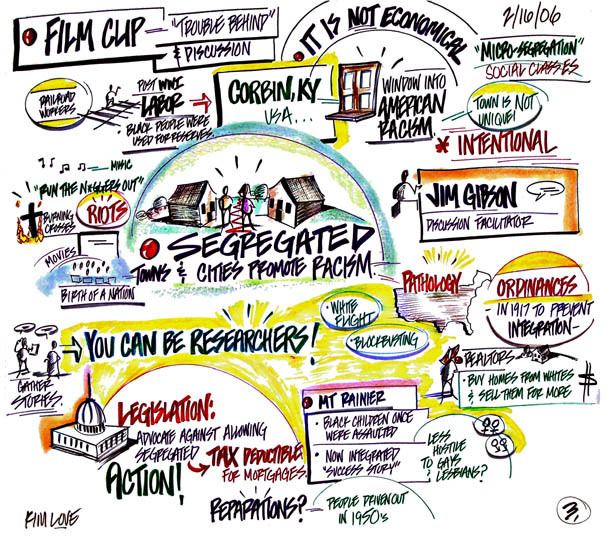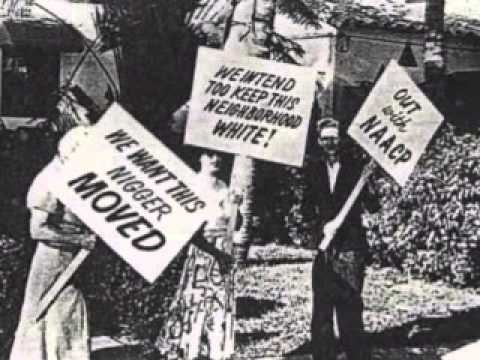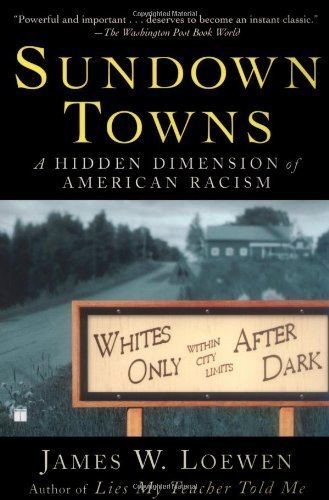 | ||
Sundown towns, sometimes known as sunset towns or gray towns, are all-white municipalities or neighborhoods in the United States that practice a form of segregation by enforcing restrictions excluding people of other races via some combination of discriminatory local laws, intimidation, and violence. The term came from signs that were posted stating that colored people had to leave the town by sundown. Since the Supreme Court's 1917 ruling in Buchanan v. Warley, racial discrimination in housing sales has been illegal, but lingering racial prejudice against non-white residents remains in certain communities to this day.
Contents
- The history of sundown towns this day forward msnbc
- History
- Identifying Sundown Towns
- Other people of color targeted
- Travel guides
- Sundown Town Misconceptions
- Sundown Suburbs and Inburbs
- Sundown Towns in Popular Culture
- Films
- References

The history of sundown towns this day forward msnbc
History

Some communities placed at their borders signs with statements similar to the one posted in Hawthorne, California, in the 1930s, which read: "Nigger, Don't Let The Sun Set On YOU In Hawthorne". James W. Loewen, the Washington, D.C.-based author, told The Washington Post in 2006 he found reports of thousands of such places, and sometimes, the sign makers tried to get clever. Some came in a series, like the old Burma-Shave signs, saying: " . . . If You Can Read . . . You'd Better Run . . . If You Can't Read . . . You'd Better Run Anyway."

During the nadir of American race relations post U.S. Civil War, about 1890-1940, many thousands of towns became sundown towns. African-Americans, who had lived predominantly in rural areas in the northern states, moved to major urban centers that were not sundown towns. Towns in the southern states, where many of the workers were African-Americans, were less often sundown towns.

In some cases, the exclusion was official town policy or was promulgated by the community's real estate agents via exclusionary covenants governing who could buy or rent property. In others, the policy was enforced through intimidation. This intimidation could occur in a number of ways, including harassment by law enforcement officers.

Since the Civil Rights Movement of the 1950s and 1960s, and especially since the Civil Rights Act of 1968 prohibited racial discrimination concerning the sale, rental, and financing of housing, the number of sundown towns has decreased. However, as sociologist James W. Loewen writes in his book on the subject, Sundown Towns: A Hidden Dimension of American Racism (2005), it is impossible to precisely count the number of sundown towns at any given time, because most towns have not kept records of the ordinances or signs that marked the town's sundown status. He further notes that hundreds of cities across America have been sundown towns at some point in their history.
Additionally, Loewen notes that sundown status meant more than just that African-Americans were unable to live in these towns. Essentially any African-Americans (or sometimes other ethnic groups) who entered or were found in sundown towns after sunset were subject to harassment, threats, and violent acts—up to and including lynching.
For example, the city of Goshen, Indiana was a sundown town for much of its history, forbidding African Americans from living in, or entering, the town, often under threat of violence. In March 2015, the city acknowledged this part of its past, apologizing and saying that it no longer condones such behavior.
The U.S. Supreme Court case Brown v. Board of Education ruled segregation of schools unconstitutional in 1954. Sociologist James Loewen argues that the case caused some municipalities in the South to become sundown towns. Missouri, Tennessee, and Kentucky saw drastic drops in African American populations living in the states following the decision.
Identifying Sundown Towns
Sundown towns are often identified by using U.S. Census data. Towns that have all-white populations through multiple decades or had a sharp decline in the African American population can be further assessed possible sundown towns.
Towns that saw a sharp drop in the African American population between two censuses can be classified as sundown towns if the African American absence was intentional. Credible sources including tax and census records, newspaper articles, county histories, and WPA files are required to confirm a town as a sundown town.
Extensive research beyond examining U.S. Census data is required in order to document a sundown town. Researchers must determine that the absence of African Americans in a town is due to a systematic policy and not change in demographics.
Other people of color targeted
African-Americans were not the only people of color driven out of some towns where they lived. One example, according to Loewen, is that in 1870, Chinese people made up one-third of Idaho's population. Following a wave of violence and an 1886 anti-Chinese convention in Boise, almost none remained by 1910. In another example, the town of Gardnerville, Nevada is said to have blown a whistle at 6 p.m. daily alerting Native Americans to leave by sundown. Three additional examples of the numerous road signs documented during the first half of the 20th century include:
Jews were also excluded from living in some sundown towns, such as Darien, Connecticut and Lake Forest, Illinois (which kept anti-Jewish and anti-African American housing covenants until 1990).
In Maria Marulanda's 2010 article in the Fordham Law Review titled Preemption, Patchwork Immigration Laws, and the Potential for Brown Sundown Towns, Marulanda outlines the possibility for non-blacks to be excluded from towns in the United States. Marulanda argued that immigration laws and ordinances in certain municipalities could create similar situations to those experienced by African Americans in sundown towns. Hispanic Americans are likely the target in these cases of racial exclusion.
Travel guides
Described by former NAACP President Julian Bond as "One of the survival tools of segregated life", The Negro Motorist Green Book (at times titled The Negro Traveler's Green Book or The Negro Motorist Green-Book, and commonly referred to simply as the "Green Book") was an annual, segregation-era guidebook published by Hackensack, New Jersey letter carrier turned New York travel agent Victor H. Green, for African-American motorists. It was published in the United States from 1936 to 1966, during the Jim Crow era, when discrimination against non-whites was widespread. Road trips for African-Americans were fraught with inconveniences and dangers because of racial segregation, racial profiling by police, the phenomenon of travelers just "disappearing", and the existence of numerous sundown towns. According to author Kate Kelly, "there were at least 10,000 'sundown towns' in the United States as late as the 1960s; in a 'sundown town' nonwhites had to leave the city limits by dusk, or they could be picked up by the police or worse. These towns were not limited to the South—they ranged from Levittown, New York, to Glendale, California, and included the majority of municipalities in Illinois."
Sundown Town Misconceptions
According to sociologist James Loewen, the American public generally associates racism with the Deep South. Due to this misconception, sundown towns are thought to only exist in the South. Hollywood also plays into this misconception by portraying sundown towns as only occurring in the Southern United States. Loewen asserts that sundown towns are more likely to exist in towns and suburbs in the Northern region of the United States.
Northern parts of the United States were also home to sundown towns. Between 1890 and 1940, several counties in New England forced their African American populations to leave. African Americans living in rural New England were driven to urban areas.
Sundown Suburbs and Inburbs
Many suburban areas in the United States were incorporated following the establishment of Jim Crow laws. The majority of suburbs were made up of all-white residents from the time they were first created. Harassment and inducements helped to keep African Americans out of new suburban areas. Schooling also played a large role in keeping the suburbs white. The suburbs often did not provide schools for blacks, causing black families to send their children to school in large municipalities such as Atlanta, Georgia. African Americans were forced to pay a fee to the central municipality in order for their children to attend school there. Despite the fee, they were not provided transportation to school in the city. The education barrier to African Americans in the suburbs caused many to migrate to cities across the United States. In addition to the educational barriers, home developers in the 1950s built all-white subdivisions, pushing more African Americans out of the suburbs.
The African Americans that lived in suburban areas were janitors, cooks, and gardeners for white families. The few African Americans that lived in the suburbs occupied their own working-class sections of the neighborhoods. Towns with interracial populations such as Chamblee, Georgia, and Pearl, Mississippi forced their African Americans to leave town as they developed into suburbs. Home developers in the 1950s built all-white subdivisions, pushing more African Americans out of the suburbs.
Sundown Towns in Popular Culture
In her famous memoir I know Why the Caged Bird Sings, poet Maya Angelou describes sundown towns existing in parts of the South. She describes Mississippi as inhospitable to African Americans after dark: "Don't let the sun set on you here nigger, Mississippi."
The 1959 film by Sidney Lumet, The Fugitive Kind, starring Marlon Brando and Anna Magnani, mentions sundown towns. A small town sheriff in the south tells Brando's character about a sign in a town that says, "Nigger, don't let the sun go down on you in this county"
Oprah Winfrey visited Forsyth County, Georgia on a 1987 episode of her television show. The county is infamous for its expulsion of African Americans at the beginning of the 20th century.
Playwright John Henry Redwood III wrote the play No Niggers, No Jews, No Dogs after he saw the words written on a sign from a sundown town in Mississippi. The play is set in a sundown town in the American South
Tennessee Williams' play Orpheus Descending features a sign reading "nigger, don't let the sun go down on you in this county."
Films
Some cinematic treatments of the subject include:
